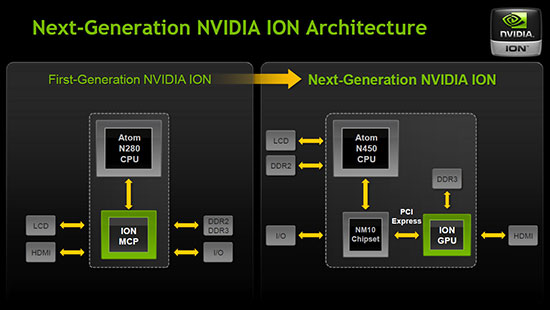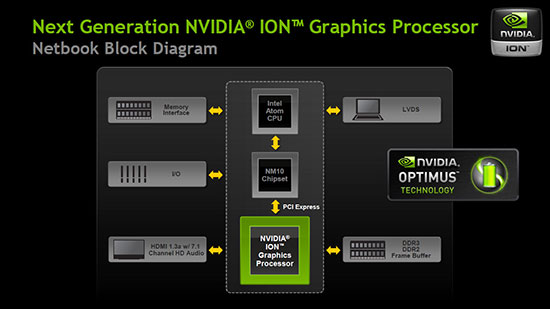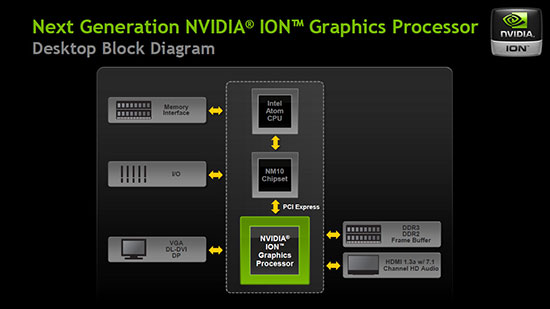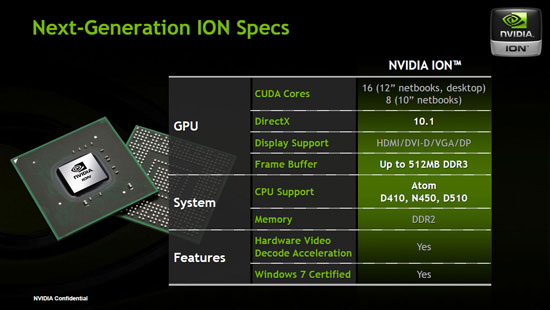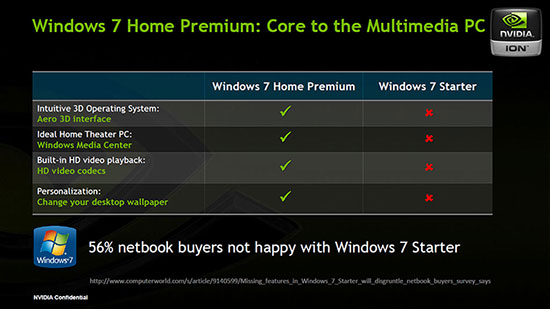
Original Link: https://www.anandtech.com/show/2951/nvidia-s-next-generation-ion-announced-optimus-a-16-core-version
NVIDIA's Next Generation ION Announced, Optimus + a 16-core Version
by Jarred Walton on March 2, 2010 12:01 AM ESTThe netbook market has exploded since its introduction; there are over 40 million netbooks out in the wild today, which is tremendous growth for what is essentially a new class of PC. With such a large number of mobile devices, it's only natural for companies like NVIDIA to look for ways to get a slice of the netbook pie. As a graphics company, NVIDIA is quick to point out how poorly Intel's IGPs perform, and the GMA 950 paired with Atom netbooks is particularly slow. As an alternative to Atom+GMA 950, NVIDIA created the ION platform, which would provide dramatically improved graphics along with HD video decoding.
The first such implementation combined the GeForce 9400M chipset with an Atom N270/N280 for netbooks, or an Atom 330 for a nettop. A single-core Atom CPU is just barely able to handle 720p H.264 decoding on its own (with the CoreAVC codec—other less optimized codecs would still drop frames). 1080p support? Fahgeddaboutit! NVIDIA's ION nettops provided the necessary hardware to make a tiny HTPC box capable of handling Blu-ray playback, and the CPU and chipset are efficient enough that passive cooling isn't a problem.
On the netbook side, ION was a tougher sell. 1080p support is a nice bullet feature, but when most netbooks have 1024x600 LCDs, does HD support really matter? Plus, you would need an external USB Blu-ray drive to make it work. There's still gaming, and with Flash 10.1 (now at Beta 3) acceleration you can certainly make the argument that an ION netbook provides a superior user experience compared to stock Atom netbooks, but the caveats don't end there. NVIDIA stated that their chipset power requirements were "competitive" with Intel's chipset, but they appear to be taking performance into the equation. Our own numbers suggest that a good GMA 950+N280 solution is anywhere from 17% (H.264 decode) to over 35% (Internet surfing) more power efficient than the original ION—that's using the ASUS 1005HA and the HP Mini 311 as a point of reference. So you'd be stuck with less battery life but more features, with a higher price as well.
Things got quite a bit more complicated with the release of the Pine Trail platform and Pineview processors. Besides the fact that Pine Trail is even more power efficient (up to 70% more battery life relative to ION in Internet testing), Intel moved their IGP solution into the CPU package and eliminated the old FSB link. The Atom N450 links to the NM10 chipset with a proprietary DMI connection and NVIDIA doesn't make—and legally can't make—a compatible chipset, so using a non-Intel chipset with N450 simply isn't an option. The problem with Pine Trail is that HD video decoding remains difficult, unless you add a separate decoder chip, and gaming and other aspects of the user experience are still lackluster—N450 netbooks typically make do with Windows 7 Starter. Lucky for NVIDIA, they have some new technology called Optimus that makes all of this a moot point.
If you've got any math skills, you've probably already put two and two together to figure out what NVIDIA is announcing today. The Next Generation ION (NG-ION) platform consists of a Pineview netbook with a discrete graphics chip from NVIDIA, with Optimus allowing the GPU to switch on/off as needed. Note that there is no Optimus technology for nettop solutions, which will simply use an NVIDIA discrete GPU all the time. On a nettop that's always plugged in, NG-ION might use ~3W more power at idle, but that's not enough to worry about. There's also a benefit to just keeping things simple by using a standard discrete GPU.
Simplifying NG-ION like we just did is great for the layman, but there are plenty of other technical aspects to discuss that make things a bit more interesting. We don't have hardware for testing, so all we can pass along are NVDIA's performance information, but they make sense as we'll see in a moment. We'll also discuss some of the implementation specific details, expected availability, etc.
Getting Technical with Next Generation ION
Obviously, there are some changes to the core ION design, since the previous version was a chipset with integrated graphics while the new version only has to worry about GPU duties. The manufacturing technology for ION has also shifted from 55nm for the first generation to 40nm hardware; this results in a package size reduction from 35x35mm down to 23x23mm. Outside of clock speeds what we're looking at is essentially a netbook/nettop version of the GeForce G 210M (with half the SPs on certain models—see below), with full DirectX 10.1 support. The memory technology will continue to be DDR2, which comes from the Intel NM10 chipset.
Since NG-ION is now a discrete GPU, it also comes with up to 512MB of dedicated DDR3 memory. This alone should provide better performance than the old version, as there's now more bandwidth to go around. NVIDIA isn't disclosing clock speeds yet, but given the process shrink we would expect moderately higher clocks. That probably won't matter much for complex games, as the Atom CPU will continue to be a bottleneck, but it will help with some games and CUDA applications. NVIDIA says that in general NG-ION will be 50 to 100% faster than the original ION.
Like the previous iteration of ION, there will be two versions of ION. Nettop IONs will come with 16 SPs (aka CUDA Cores), while netbooks will come with either 16 SPs or 8 SPs. The 8 SP version is designed specifically to fit within the thermal constraints of a 10.1" chassis, so we'll actually see 10" netbooks with ION this time around. Fewer CUDA Cores may impact gaming performance (depending on the title) and CUDA applications, but NVIDIA says Blu-ray playback will continue to work, so by extension HD video decoding won't be a problem.
The one aspect of the technology that NVIDIA wouldn't discuss extensively is how Optimus works within the bandwidth constraints imposed by the NM10 chipset. Just to clarify, NM10 provides just four PCI Express 1.1 lanes, and while a manufacturer could choose to use all of those for the ION GPU NVIDIA says most will use a single link, leaving the other lanes open for additional devices. PCIe 1.1 provides 250MB/s of bidirectional bandwidth on each link, so that means Optimus will have to work within that constraint. Optimus copies content from the GPU memory to the system memory directly, to avoid any issues with flickering displays, but that means NG-ION will need to transmit a lot of data over a relatively narrow link.
Driving a low resolution 1024x600 LCD at 60FPS isn't a problem, but even at 1366x768 we are at the limits of x1 bandwidth (such a display would require 251.78MB/s to be exact). NVIDIA says that NG-ION won't have any trouble driving up to 1080p displays, so naturally we were curious how they manage to get 1920x1080x32-bit @ 60FPS (497.66MB/s) over a 250MB/s link. For now, unfortunately, they aren't saying, other than that there's some "intelligent work" going on in the drivers. Real-time compression is one option, and if you only transmit the meaningful 24-bits of color you can save 33% of the total bandwidth. All we know is that NVIDIA says it works, that the content isn't compressed (presumably that means no lossy compression, as clearly there has to be some form of compression happening), and that they're not overclocking the PCIe bus. In short, Optimus has some "special sauce" that NVIDIA doesn't want to disclose (yet?).
Update: The answer was staring me in the face, but I missed it. NVIDIA was kind enough to provide the remaining information. If you read below, HDMI requires the GPU, since the Atom IGP doesn't support HDMI output. That solves any question of 1080p support, since the only thing going over the x1 link at that point is the compressed video stream. For content running on the laptop LCD, the maximum resolution supported by the Atom LVDS controller is 1366x768, so NVIDIA can do two things. First, any content at a higher resolution (e.g. 1080p Blu-ray) can be scaled down to 1366x768 before going over the x1 PCI-E bus. Second, most videos are at 30p or 24p, so 1366x768x32-bit @ 30FPS is well withing the bandwidth constraints of an x1 link (125.9MB/s). For 1366x768 @ 60FPS, rendering internally at 32-bit (with the Alpha/Z/Bump channel) and then transmitting the final 24-bits of color data still seems like a good solution, but NVIDIA didn't clarify if they're doing anything special for that case or if they're just saturating the x1 link.
Speaking of Optimus, that also means that NG-ION netbooks are limited to Win7 systems. This won't be a concern for most users, but know in advance that installing Linux on such a netbook would mean the loss of your GPU functionality (short of some enterprising individuals figuring out how to do Optimus on their own, which I wouldn't put past the Linux community given time). NVIDIA informs us that there are currently no plans for Optimus on desktops or on other OSes.
One item that created a bit of confusion for us was the Windows 7 Starter requirement. NVIDIA is able to handle the Aero UI with ION, obviously, but what does that mean for Optimus? If GMA 3150 can't run Aero on its own, Optimus would have to constantly power up the GPU to handle Aero effects. That would be counterproductive and as far as we can tell, the real issue with Windows 7 Starter comes down to manufacturers wanting to save money by going with Starter instead of install Home Premium. GMA 3150 can handle Aero (albeit barely), so Optimus doesn't need to worry about using the GPU for standard Windows applications with Pineview CPUs like the N450. Whether all ION netbooks will require Home Premium isn't clear, but we see no reason to pair such a netbook with Win7 Starter.
Finally, because of the IGP restrictions on the GMA 3150, NG-ION will require the GPU to be active any time an HDMI connection is used. GMA 3150 does not have support for HDMI at all, so the HDMI connection will run solely off the ION GPU. Considering HDMI means you're tethered to an external display this shouldn't be a problem, as you can easily plug in the netbook. Second, GMA 3150/NM10 has a resolution limit of 1366x768 for LVDS and 1400x1050 for VGA, so higher resolutions will need ION—but again, higher resolutions will only be available with an external display. The VGA connection is supposed to come from the IGP, so the resolution limit for VGA will remain in effect.
ION: TNG Lives Long and Prospers
And that pretty much wraps up all we know about Next Generation ION. It will do everything that current ION platforms can do, only better. It will support Pine Trail, it will be 50-100% faster, and on netbooks Optimus will dynamically switch the GPU on/off as needed. Given the alternative between spending around $25 on a Broadcom HD chip compared to $50 to add an NVIDIA ION chip, NVIDIA obviously hopes netbook manufacturers will see enough added value to skip the Broadcom HD and go for NG-ION. If you're not happy with Pine Trail, we have to agree with NVIDIA on this one. Flash 10.1 support has been much better on NVIDIA GPUs than on the competition (though the 10.1 Beta 3 adds Crystal HD support), there are a few potentially useful CUDA apps, and light gaming support is an added bonus.
Casual games like Spore, Monkey Island, and World of WarCraft should all run reasonably well […and a little birdie told us StarCraft 2 runs acceptably as well!], but any game that stresses the CPU is going to cause problems. That's no surprise, since Pineview is virtually the same performance as Diamondville; it just uses less power. Hard drive performance has also been a sore spot on Atom, from a combination of the low-end CPU and RAM specs and the use of bottom-of-the-barrel hard drives. We'll have to wait for test hardware to see if things have improved much in respect to storage performance.
NVIDIA continues to promote CUDA applications like Badaboom and vReveal, along with multimedia support headlined by Flash 10.1. If you happen to be a YouTube junky, full screen Flash videos will no longer be a problem on an ION netbook. Besides Flash videos, NVIDIA has worked quite a bit with Boxee to provide a nice multimedia library setup that will run great on ION. NVIDIA also hinted that "something big" was in the works that would make it "foolish to not have a GPU" in your next netbook/laptop, but as usual they couldn't give us specifics right now. Marketing bluster or a real killer app? Hopefully we'll know by the end of the year.
We expect NG-ION netbooks and nettops to start showing up later this month, with prices similar to what we saw with the previous ION solutions. NVIDIA says we'll see 30 or more NG-ION designs by summer 2010. Two of the first netbooks with NG-ION scheduled for release are the Acer Aspire One 532G and the ASUS 1201PN. The 532G is also the first 10.1" ION, with a 1366x768 LCD to make HD videos (and general Windows use) more palatable. We really hope all ION-based netbooks follow suit and use a 1366x768 LCD as a minimum. The 1201PN is the next iteration of the 1201N, so we expect it to use an Atom D510 with ION—and hopefully eke out a bit more battery life, though the D510 will make that difficult as it lacks SpeedStep support. On the nettop side, we should see the Acer Aspire Revo, ASUS EeeBox, and Zotac ZBOX in the near future. There are also all-in-one designs coming with the ASUS EeeTop 2010PNT, Compaq CQ1, and Lenovo C200.
When looking at pricing, something else to keep in mind is Windows 7 Starter vs. Home Premium. We don't particularly care for Starter; it's not horrible, but the Aero UI and other personalization options (i.e. wallpaper) are definitely missed. ION netbooks should include Home Premium instead of Starter, so there's definitely added value in ION beyond the GPU. If you're looking at a $300 Pine Trail netbook with Win7 Starter versus a $400 NG-ION with Win7 Home Premium, we'd recommend the latter—especially if it comes with 2GB RAM instead of the meager 1GB found on most sub-$350 netbooks.
After the Optimus announcement, we could have pretty much guessed what Next Generation ION would entail, but that doesn't make the hardware any less impressive. ION has always been a far superior multimedia solution than regular Atom-based netbooks/nettops, and the new version keeps all of the good features, boosts performance, and adds seamless switching between IGP and GPU as needed. That means better battery life when running common applications, and improved features and performance when you need it. Atom-based systems are still going to feel slow for a lot of tasks, and while CULV laptops are competitive they're also a sizable jump in cost; until we can get CULV with Optimus graphics for under $500 there's a clear market for Next Generation ION.


